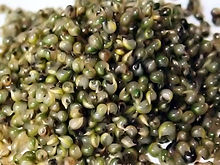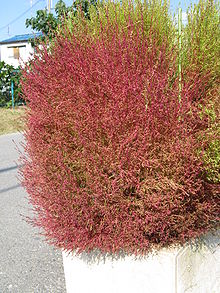- Bassia scoparia
-
Bassia scoparia 
Bassia scoparia Scientific classification Kingdom: Plantae (unranked): Angiosperms (unranked): Eudicots (unranked): Core eudicots Order: Caryophyllales Family: Amaranthaceae Subfamily: Camphorosmoideae Genus: Bassia Species: Bassia scoparia Synonyms Kochia scoparia
Bassia scoparia (synonym Kochia scoparia) is a shrub which is native to Eurasia.[1] It has introduced populations in many parts of North America,[2] where it is found in grassland, prairie, and desert shrub ecosystems.[1] Its vernacular names include burningbush,[3] ragweed, summer cypress, fireball, and Mexican fireweed.
Contents
Biology
It reproduces by seed, dispersed by wind, water, and especially by the whole plant detaching and tumbling in the wind (see Tumbleweed).[1] The seed does not persist in the soil seed bank; it germinates or dies within about a year.[1]
Bassia scoparia is a C4 plant, specifically of the NADP-ME type[4][5].
Uses
Uses of Bassia scoparia include human food and traditional medicine, forage for livestock, and erosion control.
Tonburi
The seeds of Bassia scoparia are eaten as a food garnish called tonburi (とんぶり) (Japanese). Its texture is similar to caviar, and it also is called "land caviar", "field caviar" and "mountain caviar". In Japan, tonburi is a delicacy (chinmi) of Akita prefecture. After harvesting the seeds are dried. To prepare them, the seeds are boiled and soaked in cold water for about a day, then rubbed by hand to remove the outer skin. The seeds are 1–2 mm in diameter, glossy with a black-green color.
Tonburi also is used in traditional Chinese medicine. It may prevent metabolic disorders such as hyperlipidemia, hypertension, obesity and atherosclerosis. In a study of mice fed a high-fat diet, an extract of tonburi did limit obesity.[6] Bassia scoparia seeds contain momordin Ic, a triterpene saponin.[7]
Forage
The plant is a moderately useful forage for livestock, and a potential forage crop for dry lands.[8] However, its use is limited by toxicity when fed in large quantities. Livestock grazing principally on lush stands of Bassia scoparia sometimes experience weight loss, hyperbilirubinemia, photosensitization, and polyuria.[9] When used as the only feed for weeks, Bassia scoparia hay may cause toxicity in cattle.[10]
Other
Bassia scoparia is planted for ornament or erosion control.[1] It is a known hyperaccumulator of Chromium, Lead, Mercury, Selenium, Silver, Zinc,[11][12] and Uranium,[13] , and as such can be used for phytoremediation.
Systematics
The species was first published in 1753 by Carl Linnaeus, who named it Chenopodium scoparium. In 1809, it was included into the genus Kochia by Heinrich Schrader, and in 1978, into genus Bassia by A.J.Scott. Recent phylogenetic research comfirmed, that Kochia has to be included in Bassia[4].
References
- ^ a b c d e Kochia scoparia, Fire Effects Information System
- ^ Bassia scoparia (L.) A.J. Scott, USDA PLANTS
- ^ USDA PLANTS Profile for Bassia scoparia (L.) A.J. Scott burningbush. Retrieved October 19, 2007.
- ^ a b Gudrun Kadereit & Helmut Freitag: Molecular phylogeny of Camphorosmeae (Camphorosmoideae, Chenopodiaceae): Implications for biogeography, evolution of C4-photosynthesis and taxonomy, In: Taxon, Volume 60 (1), 2011, p. 51-78.
- ^ Muhaidat, R.; Sage, R. F.; Dengler, N. G. (2007). "Diversity of Kranz anatomy and biochemistry in C4 eudicots". American Journal of Botany 94: 362. doi:10.3732/ajb.94.3.362
- ^ Han LK, Nose R, Li W, Gong XJ, Zheng YN, Yoshikawa M, Koike K, Nikaido T, Okuda H, Kimura Y (October 2006). "Reduction of fat storage in mice fed a high-fat diet long term by treatment with saponins prepared from Kochia scoparia fruit". Phytotherapy Research : PTR 20 (10): 877–82. doi:10.1002/ptr.1981. PMID 16892459.
- ^ H. Matsuda, Y. Li, J. Yamahara, M. Yoshikawa (1999) Inhibition of gastric emptying by triterpene saponin, momordin Ic, in mice: roles of blood. J Pharmacol Experimental Therapy, volume 289, pages 729-34. PubMed
- ^ Rankins DL, Smith GS, Hallford DM (July 1991). "Serum constituents and metabolic hormones in sheep and cattle fed Kochia scoparia hay". Journal of Animal Science 69 (7): 2941–6. PMID 1885403.
- ^ Rankins DL, Smith GS, Hallford DM (July 1991). "Altered metabolic hormones, impaired nitrogen retention, and hepatotoxicosis in lambs fed Kochia scoparia hay". Journal of Animal Science 69 (7): 2932–40. PMID 1885402.
- ^ Rankins DL, Smith GS, Hallford DM (September 1991). "Effects of metoclopramide on steers fed Kochia scoparia hay". Journal of Animal Science 69 (9): 3699–705. PMID 1938652.
- ^ McCutcheon & Schnoor 2003, Phytoremediation. New Jersey, John Wiley & Sons, page 898.
- ^ Phytoremediation. By McCutcheon & Schnoor. 2003, New Jersey, John Wiley & Sons pg 19.
- ^ Enhancing Phytoextraction: The Effect of Chemical Soil Manipulation on Mobility, Plant Accumulation, and Leaching of Heavy Metals. By Ulrich Schmidt. In J. Environ. Qual. 32:1939-1954 (2003)
Categories:- Bassia
- Tumbleweeds
- Japanese cuisine
Wikimedia Foundation. 2010.


